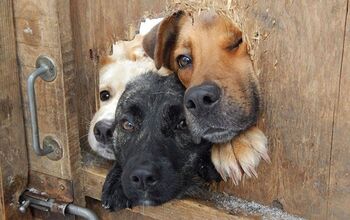Dogs and Chocolate: Why The Two Don’t Mix

Dogs have a tendency to eat whatever they can get their paws on, especially things that aren’t good for them. You’ve probably heard dogs and chocolate can be a deadly mix, but do you know why? Understanding exactly what happens to your dog when he eats chocolate can help you to prepare for the worst if your dog gets into something that he shouldn’t.
Related: Top 10 Foods That Are Bad For Dogs
Why Dogs and Chocolate Don’t Get Along
Chocolate is made from the seeds of the cacao plant and it contains two ingredients that can be harmful to dogs. The first is caffeine which typically does not result in poisoning but can still cause complications, especially in small dogs. More dangerous, however, is the chemical theobromine which is found in greater quantities – especially in dark chocolate. Theobromine can act as a diuretic, a blood vessel dilator, a muscle relaxant, and a heart stimulant. If ingested in significant quantities, theobromine can actually lead to poisoning. Different types of chocolate have different levels of theobromine, so your dog might have different side effects if he eats milk chocolate than if he eats baking chocolate. Milk chocolate only contains about 45 to 60mg of theobromine per ounce whereas baking chocolate or dark chocolate contains as much as 450 mg per ounce.
Related: Chock Full Of Carob Chip Dog Treat Recipe
Symptoms of Chocolate Poisoning
A toxic dose of theobromine may be as little as 20mg per kilogram of your dog’s body weight – this amount of theobromine could cause symptoms like excessive drooling, vomiting, or diarrhea. At larger doses of 40mg per kilogram body weight or more, your dog might experience more severe symptoms including racing heartbeat, high blood pressure, and even cardiac arrhythmia. If your dog ingests 60mg per kilogram bodyweight of theobromine, he may experience neurologic symptoms including twitching, tremors, or seizures. Your dog’s reaction to theobromine poisoning may vary depending on his size, but doses as high as 200mg per kilogram bodyweight have been known to be fatal. Unfortunately, symptoms of chocolate poisoning may take a few hours to develop and they have been known to last for several days in extreme cases.
What to Do if Your Dog Eats Chocolate
If your dog eats chocolate, your first step is to contact your veterinarian or the Pet Poison Control Hotline. You will also need to determine how much chocolate your dog ate and what type – this will help to determine your dog’s risk for theobromine poisoning. If your dog begins to display symptoms of theobromine poisoning you may need to induce vomiting and then have your dog examined by a veterinarian. In extreme cases, your veterinarian may administer activated charcoal to help stop your dog’s body from absorbing the theobromine. IV fluids may also help to dilute the toxin in your dog’s bloodstream to help prevent poisoning. Even if your dog only ingests a small amount of chocolate – not enough to require induced vomiting – you should monitor him for side effects over the next 24 to 48 hours.
To keep dogs and chocolate away from each other, while still satisfying your sweet tooth, make sure that all forms of this dessert is out of you pup’s reach. Even if you are careful, however, your dog may still get into things that he shouldn’t. In the event that your dog eats chocolate, understanding the risks and knowing what to do could save your dog from the effects of theobromine poisoning.

Kate Barrington is the loving owner of two cats (Bagel and Munchkin) and a noisy herd of guinea pigs. Having grown up with golden retrievers, Kate has a great deal of experience with dogs but labels herself a lover of all pets. Having received a Bachelor's degree in English, Kate has combined her love for pets and her passion for writing to create her own freelance writing business, specializing in the pet niche.
More by Kate Barrington























